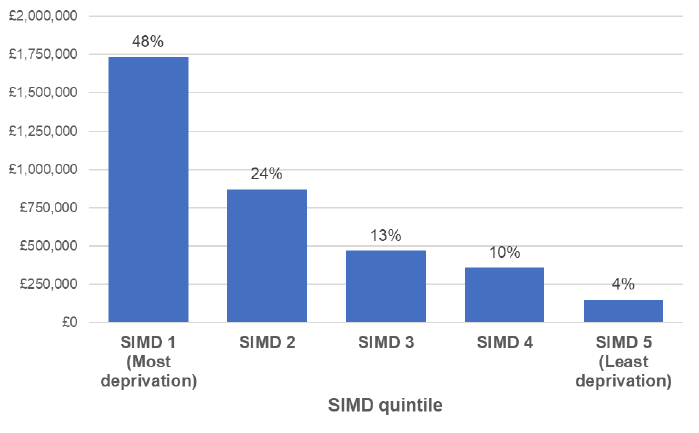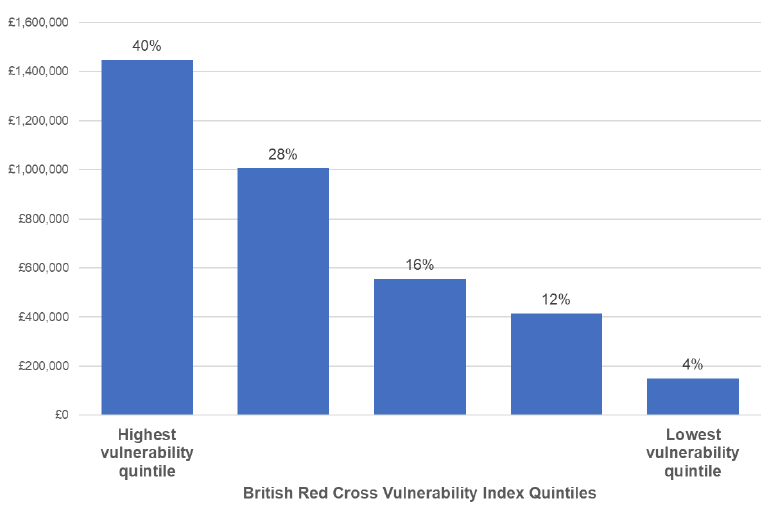Wellbeing Fund: analysis of awards
Analysis of the data on applications and awards made through the Wellbeing Fund Open Application Process and the Small Grants Fund. These funds were part of the Scottish Government’s initial 350 million overall package of funding support to communities, in response to the COVID-19 pandemic
5. Analysis of awards in relation to deprivation levels and vulnerability to the impacts of Covid-19
Communities affected by social, economic and health deprivation experience increased risk of negative social, economic and health impacts of Covid-19. To meet the fund criteria, organisations were required to demonstrate that their project would support a vulnerable group to respond to an acute need emerging in the face of the pandemic. The qualitative narratives supporting the applications make this very clear. Accordingly, we should expect to see some relationship between awards made, and areas of higher deprivation or higher vulnerability to the impacts of Covid-19.
At the level of local authorities, it is difficult to discern clear patterns of awards in relation to deprivation or vulnerability to the impacts of Covid-19. Rates of awards to organisations working in some local authorities where there are larger numbers of deprived areas – such as Glasgow City and Inverclyde – were relatively high; in others – such as North and South Ayrshire – they were relatively low. The pattern of awards reflects the sheer scale of the crisis affecting every local authority, and the fact that every local authority contains areas of high deprivation, and many communities with high levels of emerging needs in the context of Covid-19.
To understand the pattern of awards in relation to deprivation or Covid-19 vulnerability more clearly, we need to look at the data for local project delivery, where this is available.
For awards made to organisations which indicated that they were working in a specific local area, we can analyse the spread of awards in relation to deprivation levels, and levels of vulnerability to the impacts of Covid-19. This analysis assumes that the location of the organisation address represents the location of the programme delivery. There were 384 such applications, of which 229 were successful. The total amount awarded to these organisations was £3,577,634.[8]
Mapping these awards to the Scottish Index of Multiple Deprivation (SIMD),[9] shows that awards were significantly more likely to be made to organisations working in the areas of greatest need. Overall, 48% of the amount awarded went to organisations working in the most deprived 20% of areas according to the SIMD, and a further 24% went to organisations working in the next most deprived quintile (Figure 6).

Whilst vulnerability to the negative impacts of Covid-19 is likely to be concentrated in communities experiencing social, economic and health deprivation, other groups are also significantly affected across all areas of the population – notably older people, and people with particular health conditions that place them at higher risk of poor outcomes if they contract Covid-19.
At the outset of the pandemic, the British Red Cross developed a 'Covid-19 Vulnerability Index'.[10] This index combines data on population demographics, health, economic status, geographic isolation and other indicators in order to give an overall ranking of different places across the UK in terms of their population's relative vulnerability to the impacts of Covid-19. As with the SIMD, postcode areas are classified into one of five quintiles, where the first quintile represents the 20% of areas with highest vulnerability to the negative impacts of Covid-19.
When using this ranking to assess the awards for which we have local delivery data (Figure 7), we find that awards were strongly directed towards areas of higher likely vulnerability to the impacts of Covid-19. Overall, 40% of the amount awarded went to organisations working in areas that were in the highest Covid-19 vulnerability quintile.

Contact
Email: socialresearch@gov.scot
There is a problem
Thanks for your feedback